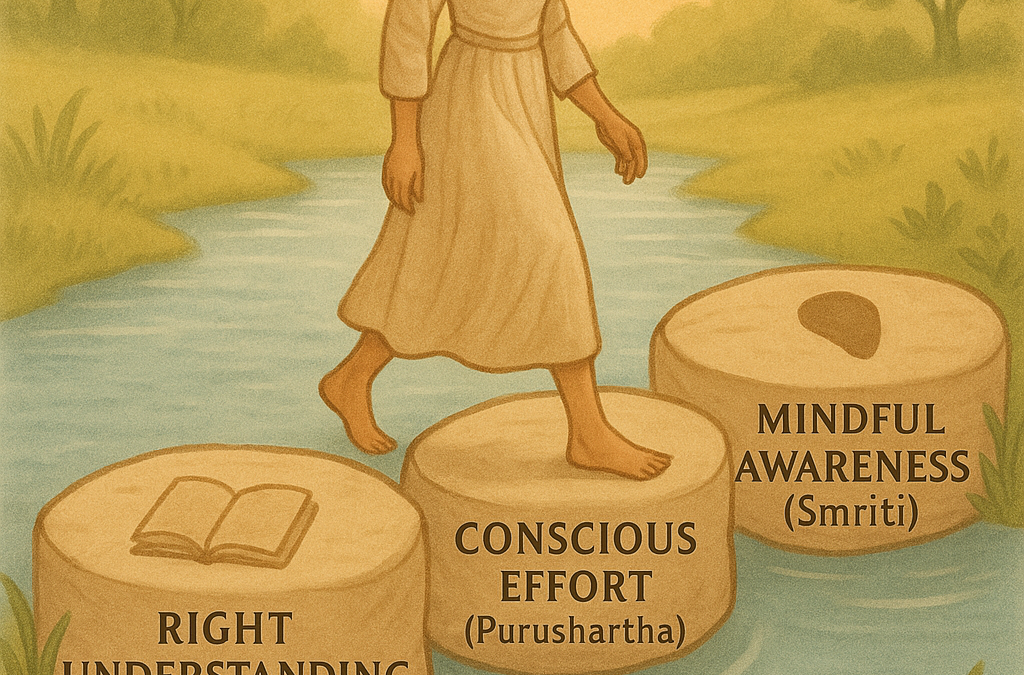In a world full of noise and rush, many of us long for something deeper—clarity, peace, a sense of purpose. The Upanishads, ancient Indian teachings, offer timeless guidance for this kind of inner transformation. Far from being abstract philosophy, they speak to real-life change.
Three key insights from the Upanishads light the way:
- Right Understanding (Jnana)
- Personal Effort (Purushartha)
- Mindful Awareness (Smriti / Upalabdhi)
Let’s explore what these mean in everyday terms.
⸻
1. Right Understanding: Seeing Clearly
Before transformation can unfold, we need to see what’s really going on—mainly within us, not just around us. The Upanishads teach that chasing status, pleasure, or even success may bring short-term relief, but not lasting peace.
When we pause and reflect, we often recognize: “Even when I get what I want, it doesn’t fulfill me for long.” That’s the beginning of wisdom.
Right understanding means tuning in to what truly matters—who we are beneath roles, labels, and distractions. It’s not about accumulating knowledge. It’s about remembering our wholeness. That clarity becomes our compass.
⸻
2. Personal Effort: Choosing Growth, Daily
Insight is essential—but it’s only the beginning. The Upanishads urge: “Wake up. Take responsibility.”
This isn’t about striving or pressure. We’re already whole. This is about releasing ego, showing up with humility, and choosing again and again to live from our deeper truth.
Old patterns may resist—that’s part of the process. But small, steady choices—pausing before reacting, practicing kindness, making time for quiet—begin to reshape us. Transformation doesn’t always look dramatic, but it’s always unfolding.
⸻
3. Mindful Awareness: Staying Connected to the Moment
Awareness is the thread that holds it all together. It’s the quiet inner presence that notices: “I’m rushing,” or “This reaction isn’t aligned with my truth.” That awareness helps us return.
The Upanishads remind us: without attention, even the wisest intentions fade. But with presence, we live more freely—with fewer regrets and greater authenticity.
This isn’t just about sitting in meditation. It’s about how we move, speak, listen, rest—moment by moment.
⸻
A Simple, Powerful Path
When understanding, effort, and awareness come together, transformation flows naturally. You don’t need to force it. You simply stay committed to the process.
The Upanishads say:
“By knowing yourself, you find strength. By living with insight, you touch the timeless.”
So walk your path gently—but keep walking.
Let your clarity guide you.
Let your effort shape you.
Let your awareness steady you.
This is a simple recipe for transformation!
What does inner transformation look like for you right now?
Feel free to share your reflections—your journey may be the light that inspires someone else to begin theirs.
Want to Go Deeper?
Books on the Upanishads
• The Ten Principal Upanishads – Swami Sivananda
• The Principal Upanishads – S. Radhakrishnan
• Eight Upanishads – Swami Gambhirananda (Advaita Ashrama)
Modern Wisdom and Practice
• The Upanishads – Eknath Easwaran
• The Essence of the Upanishads – Eknath Easwaran
• The Heart of Yoga – T.K.V. Desikachar
• The Study and Practice of Yoga – Swami Krishnananda
Yoga Therapy and Integration
• Yoga and Psychotherapy: The Evolution of Consciousness – Swami Rama et al.
• International Association of Yoga Therapists (IAYT)


